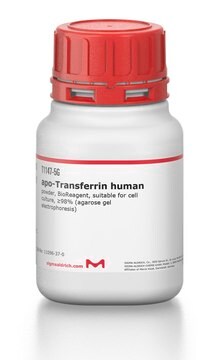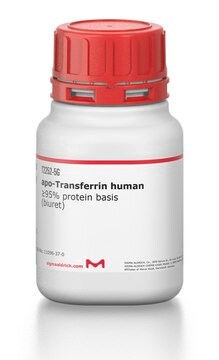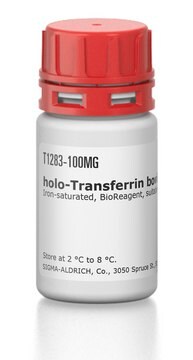T2036
apo-Transferrine human
powder, BioReagent, suitable for cell culture, ≥98% (agarose gel electrophoresis)
Synonyme(s) :
Sidérophiline, Transferrine humaine
About This Item
Produits recommandés
Gamme de produits
BioReagent
Niveau de qualité
Pureté
≥98% (agarose gel electrophoresis)
Forme
powder
Poids mol.
76-81 kDa
Concentration
~25 mM
Technique(s)
cell culture | mammalian: suitable
Impuretés
HIV and HBsAg, source material tested negative
endotoxin, tested
Solubilité
H2O: 50 mg/mL
Traces de cations
Fe: ≤0.005%
Numéro d'accès UniProt
Conditions d'expédition
ambient
Température de stockage
−20°C
Informations sur le gène
human ... TF(7018)
Vous recherchez des produits similaires ? Visite Guide de comparaison des produits
Description générale
Application
- to culture human primary pancreatic endothelial cells, Het1As (non-tumorous esophagus cells), and immortalized human colonic epithelial cells (HCEC-1CT)
- to culture α mouse liver 12 (AML-12) (mature hepatocytes) cells
- as a source for human apo-transferrin for purification before crystallography
Actions biochimiques/physiologiques
Autres remarques
Clause de non-responsabilité
Produit(s) apparenté(s)
Code de la classe de stockage
11 - Combustible Solids
Classe de danger pour l'eau (WGK)
WGK 3
Certificats d'analyse (COA)
Recherchez un Certificats d'analyse (COA) en saisissant le numéro de lot du produit. Les numéros de lot figurent sur l'étiquette du produit après les mots "Lot" ou "Batch".
Déjà en possession de ce produit ?
Retrouvez la documentation relative aux produits que vous avez récemment achetés dans la Bibliothèque de documents.
Les clients ont également consulté
Contenu apparenté
Notre équipe de scientifiques dispose d'une expérience dans tous les secteurs de la recherche, notamment en sciences de la vie, science des matériaux, synthèse chimique, chromatographie, analyse et dans de nombreux autres domaines..
Contacter notre Service technique














